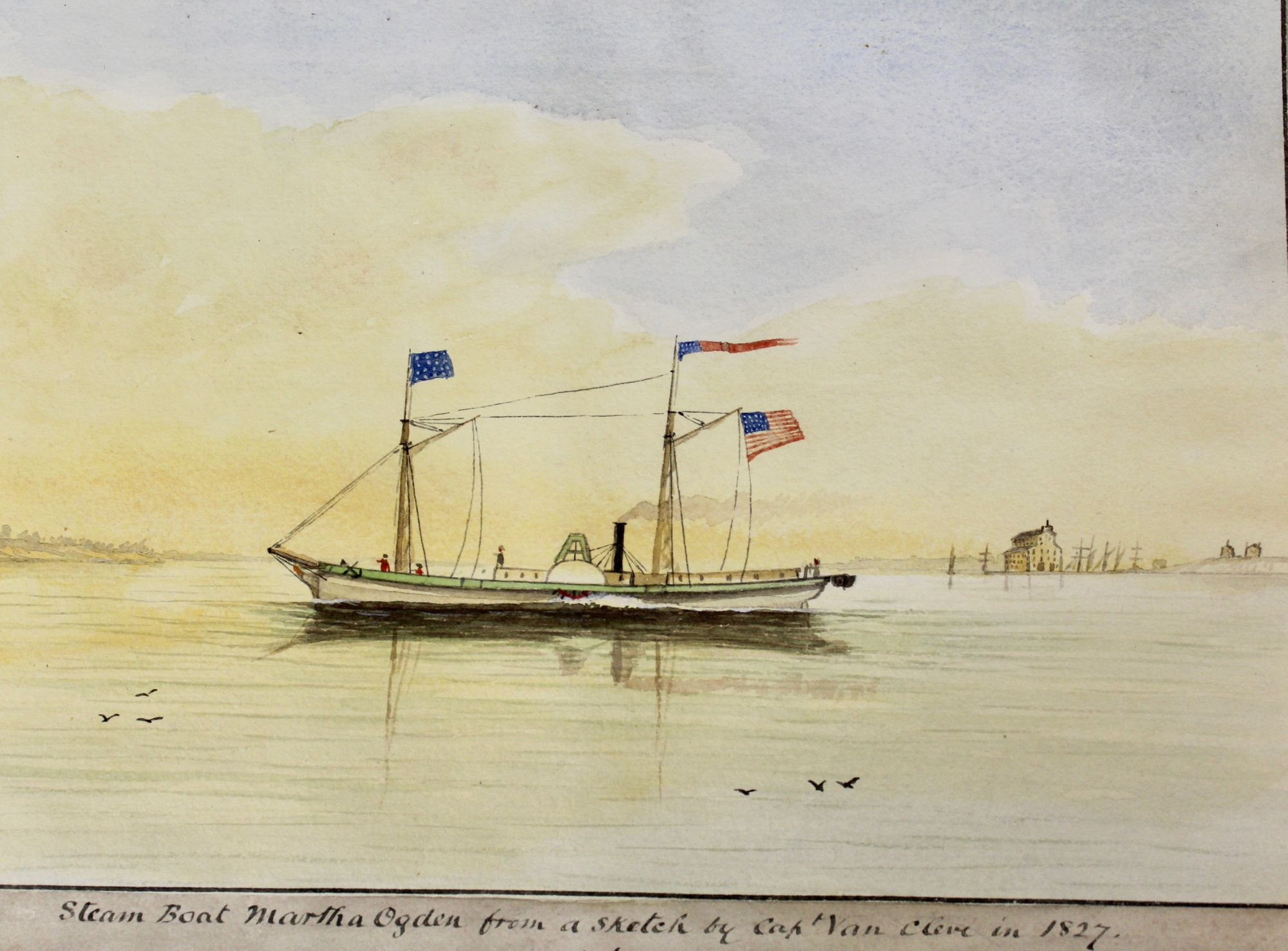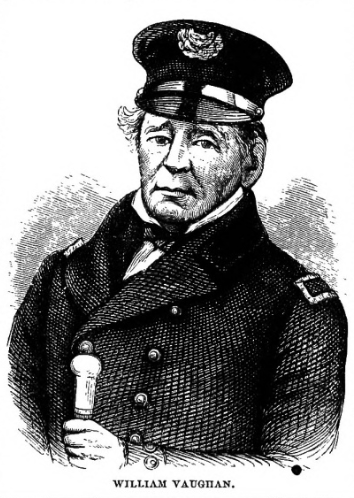In the 19th century, Mexico Bay was known as the graveyard of ships on Lake Ontario. Prevailing winds from the west and northwest frequently sent scores of schooners and steamboats off course onto sandbars or rocks, victims of unmerciful wind and high waves.

Stony Point passage near the north end of the bay was particularly treacherous. Finally, in 1837 a light was established on the southwest tip of the point. The present, privately-owned, lighthouse was built in 1869. But prior to lighthouses and the U.S. Lifesaving Service, seamen were “on their own,” except for a few merciful lakeshore residents willing to lend a hand.
One such ill-fated ship was the steamboat Martha Ogden, owned and home-ported at nearby Sackets Harbor. She and her sister ship, the Ontario (the first steamboat on Lake Ontario) comprised the fleet of the Lake Ontario Steamboat Co., incorporated January 28, 1831. Directors were Joseph and Samuel Dennison, Edward Bronson, Gerrit Smith, Elias Trowbridge, (original master of the ship), Theophilus S. Morgan, Richard L. DeZeng, Frederick Bushnell, Elisha Camp, Jacob Arnold, William Baron, John C. Bush, and Thomas L. Ogden.1
Built by Albert Crane of Sackets Harbor and named for Ogden's wife, Martha Ogden, the steamer measured 104' x 23' x 9' and registered at 150 tons. Her machinery, from the Allaire Works of New York City, included a square-crosshead, low-pressure engine to power 20-foot paddle wheels. She was rigged with two masts and three fore and aft sails.
Captain Daniel Reed was in command on her first voyage, April 1, 1825. She had more “shear” than the Ontario, but otherwise was rigged the same. Usually during the season, it made three round trips a week between Lewiston and Ogdensburg, with stops at Rochester, Oswego, Sackets Harbor, Kingston, Brockville, and Prescott.
During the winter of 1827-28, her engine was transferred to the steamboat Ontario at Hanford’s Landing, on the Genesee River near Rochester, and replaced by a high-pressure engine. The change did not prove a success. One foggy night in 1830, shortly after Capt. James Van Cleve took command, the Martha Ogden ran aground on Snake Island Shoal in the channel near Kingston. She was removed with no damage.
A story is told that in the early 1830s, Joseph Smith, founder of the Mormon Church, boarded the Martha Ogden at Genesee River with a box of “Mormon Bibles” (the recently published Book of Mormon), which he intended to circulate in the Kingston area. On the same voyage was Charles Stuart Dickson, a young English gentleman, who claimed to be an illegitimate son of King George IV. Dickson had a striking resemblance to the monarch, which gave credence to his claim. Dickson and Capt. Van Cleve decided to have a little fun with Mr. Smith by telling him that it was a criminal offense in Canada to sell his “Bibles.” Should he do so, he would surely get into serious trouble, and perhaps wind up in jail.
They carried the point so far that poor Smith was glad to take his box of “Bibles” and return to Rochester. Van Cleve recalled, “After doing the fair thing in the way of good cheer, he left for those parts where too many have been deluded by his pretended revelations.”
For several years Martha Ogden led an uneventful life, plying between Lake Ontario ports with her human cargo, being one of several steamers owned by the Dennisons of Sackets Harbor. One old-timer recalled, “She was a beauty in her day and quite speedy too.” He reminisced to a reporter:
“Speaking of the Ogden reminds me how her engineer, John Pheatt, an Oswego boy, was reinstated after he had been discharged."
"One day on the arrival of the steamer, Sam Dennison sent word to John Pheatt he wanted to see him in the office. Pheatt had an inkling that his head was going to go into the basket, as an Albany engineer was hanging around, waiting, macabre like, for something to turn up. He was at work repacking his cylinders when the messenger arrived, but like a good engineer he put his engine together before leaving, first quietly slipping a heavy oak stick into the cylinders."
“When Pheatt confronted Dennison, he was informed that the Albany engineer had been hired in his place. Pheatt went home and the new engineer went aboard. Fires were started in the furnaces, steam was produced, and just before departing the engineer thought he would work the engine to familiarize himself with it.”
“Opening the throttle gradually, the steam rushed into the cylinder, the piston moved an inch or two, stopped, and although the full head of steam was turned on, refused to go to the center. The new engineer examined all the bearings and joints but could discover nothing wrong. Finally in despair, he informed the captain that the engine would not work . . .” Although the new man did all in his power, the wheels would not revolve. The boat was loaded, the owner stormed about the wharf at the delay [but] the engine would not obey.”
“Along towards morning, Dennison, completely discomfited, sent for Pheatt, told him to go aboard . . . and resume his position with an increase of salary.”
“Pheatt went aboard, ordered the fireman to draw the fire, sent him ashore to find a blacksmith, (there were no machinists here in those days) and while he was gone quietly took off the cylinder heads, removed the oak stick, and replaced the heads. When the fireman returned, the boat was ready. As the boat swung around in the river, Pheatt stood at the gangway, smiled on Dennison, and in an audible voice remarked: ‘Discharge me, will you?’” 2
The Wreck of the Martha Ogden
The Martha Ogden, en route from Oswego to Sackets Harbor on November 12, 1832, was hit by a northwest gale and sprang a leak. When the pump failed, the crew began bailing with buckets. This proved fruitless; soon the water flooded the furnaces and put out the fires. Captain William Vaughn endeavored to make sail, but she lost her course, ran on the rocks, and went to pieces near Stony Point, about 14 miles from Sackets Harbor. Her remains were seen for years in Nuttings Bay.

Three women and eight children passengers stood on deck in the open air from 11 P.M. until 9 A.M. the next morning, when they were taken ashore by means of a basket and Dutch harness (rigged upon a line leading from the wreck to the shore). Everyone was saved – not always the case in such incidents. The passengers were grateful for the skill and courage of captain and crew.3
A letter of support was published by the Oswego Free Press, November 15, 1832. Written on behalf of the Captain, George Archer and William Miller stated, "Being on board the steamboat Martha Ogden, as passengers, when the misfortune as described above happened, and being considerable losers by it, we hereby certify that the above account of the disaster is strictly true in our belief, and that no blame whatever can be attached to Capt. Vaughan." The paper went on to say, "We understand, that in the above wreck, our fellow citizen, Captain William Vaughan, was a loser to the amount of some hundreds, which, added to his numerous other misfortunes, is very severely felt. We hope it will be made up to him."
By Richard Palmer
Richard F. Palmer is a retired newspaper editor and reporter, and was well known for his weekly historical columns for the “Oswego Palladium-Times,” called "On the Waterfront." His first article for TI Life was written in January 2015, and since then, he has written a dozen-plus others. He is a voracious researcher, and TI Life readers benefit from his interesting findings. Click here to see some of Richard Palmer’s TI Life Articles.
Sources:
- Martha Ogden, Sackets Harbor, 1823, 74’3” x 17’ 10” x 4’2”7” 48 tons. Bust figurehead, square stern. Original owners: Hunter Crane, merchant, Sackets Harbor; William Lang, New York City, owners, Daniel Reed, (later William Vaughn master). Enrolled Sackets Harbor, 9 Aug. 1823; 30 May 1826. Elisha Ely; 13 Sept. 1829, Samuel Denison, owner, John McNair, master enrollment changed to Oswego, 30 May 1830, James VanCleve, master. Letter in Relation to Steam Engines in the U.S. December 13, 1838. U.S. Treasury Department Document 21, 25th Congress, 3rd Session.
- Hough, Franklin B., History of Jefferson County, New York, Albany, N.Y., 1854, P. 564. VanCleve.
- James, Reminiscences of Early Sailing Vessels and Steamboats on Lake Ontario, 1878. (unpublished manuscript, Oswego City Hall. There are several known copies of this manuscript, including two in Buffalo, one in Detroit and one in Chicago. All vary somewhat). The vessel was not insured and was a total loss.
- Oswego Palladium, March 25, 1876.
- Oswego Palladium, Nov. 14, 1832.
Posted in: Volume 16, Issue 12, December 2021, History, People, Places
Please click here if you are unable to post your comment.
